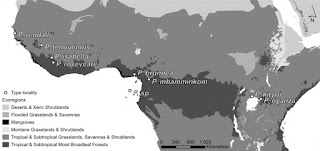 |
| Pseudoromicia mbamminkom Grunwald, Demos, Nguéagni, Tchamba, Monadjem, Webala, Peterhans, Patterson & Ruedas, 2023 |
Abstract
The Cameroon Volcanic Line, which divides the Congo Basin fauna from the West African fauna, is a known area of high endemism for various taxa, but the region’s bat fauna has received little attention. We review variation in morphological and molecular (mitochondrial Cytochrome b) characters in the Tropical African vespertilionid bat genus Pseudoromicia. Assessment of this variation indicates the existence of a new species of Pseudoromicia, from the Mbam Minkom Massif in the Centre Region of Cameroon. The new species is diagnosable by sequence data and is morphologically similar to its putative sister taxon, P. kityoi, from Uganda. Although we suggest that it be assigned to the IUCN category of Data Deficient, there should be some concern as to the conservation status of this species: the Mbam Minkom Massif ecosystem is threatened due to lack of legal conservation frameworks and exposure to increasing human pressure. The new species is in a clade with P. roseveari and P. kityoi. These three species may be relicts of a single widespread species originating in the West African “white-winged” group of Pseudoromicia that then spread east across the tropical moist broadleaf forest into East Africa, and are now restricted to a few upland rainforest patches in West Africa (P. roseveari), in outliers of the Cameroon Volcanic Line region (Pseudoromicia sp.), and the Lake Victoria area (P. kityoi). The smaller, white-winged species are hypothesized to be ancestral, with one extant putative species (P. rendalli) also extending into East and southern Africa (Van Cakenberghe & Happold, 2013). The larger, dark-winged taxa likely dispersed to East Africa and subsequently back to West Africa (e.g., Pseudoromicia sp., P. roseveari). Our data illustrate the potential importance of the Dahomey Gap and climatic changes in the evolution of this group of species.
Key words: Africa, bat, biodiversity, Cameroon, mitochondrial DNA, systematics, taxonomy
 |
| Dorsal view of the body of the holotype of Pseudoromicia mbamminkom sp.nov. The frosted look is an effect of the lighting: the coloration is homogeneous. |
 |
| Dorsal, ventral, and lateral view of the skull of the holotype of Pseudoromica kityoi (right) and the holotype of Pseudoromicia mbamminkom sp.nov. (left). |
Pseudoromicia mbamminkom sp. nov.
Mbam Minkom Serotine
Etymology. A noun in apposition, named for the type locality, the most prominent summit in its namesake Mbam Minkom Massif, an isolated gneiss inselberg formation emerging from the surrounding lowland forest matrix.
Distribution. Based on a single record at an elevationof 785 m on Mount Mbam Minkom in the Centre Region of Cameroon (Fig. 1)
Amanda L. Grunwald, Terrence C. Demos, Yvette Nguéagni, Martin N. Tchamba, Ara Monadjem, Paul W. Webala, Julian C. Kerbis Peterhans, Bruce D. Patterson and Luis A. Ruedas. 2023. A Review of Bats of the Genus Pseudoromicia (Chiroptera: Vespertilionidae) with the Description of A New Species. Systematics and Biodiversity. 21(1); 2156002. DOI: 10.1080/14772000.2022.2156002


